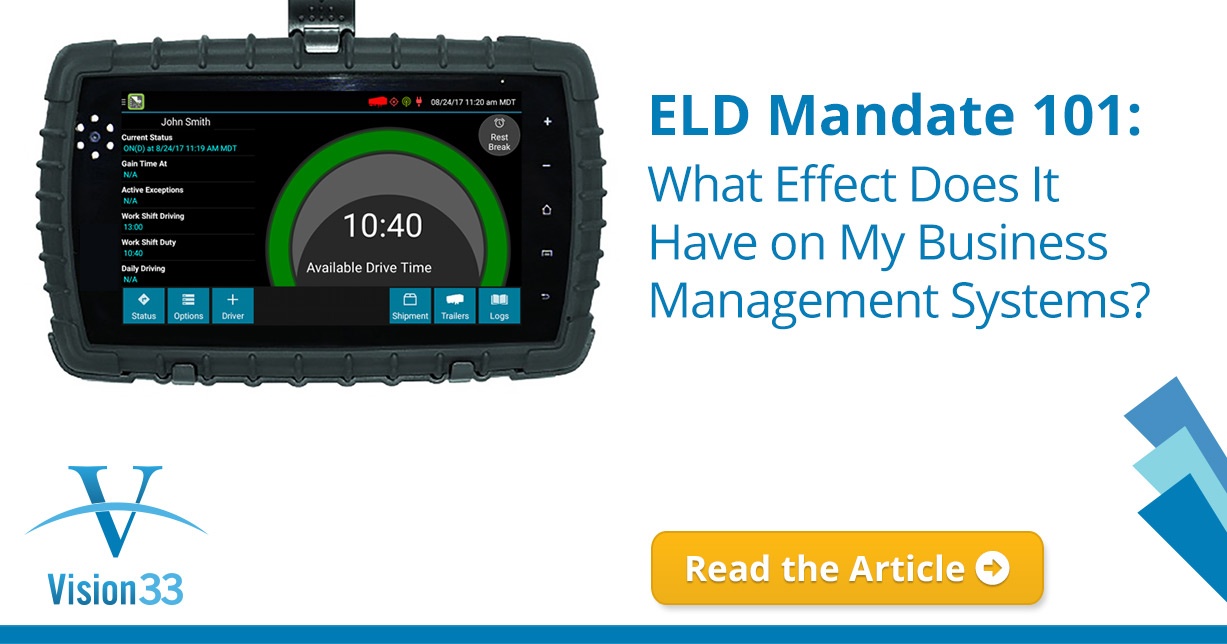Tackling Adult Beverage Challenges With Contract Manufacturing ERP
SAP Business OneBrutos by Vision33 is a perfect contract manufacturing ERP solution that helps adult beverage...

April 12, 2018
Blog > ELD Mandate 101: What Effect Does It Have on My Business Management Systems?
When you talk about transporting goods throughout the supply chain, you inevitably start talking about the logistics technology needed to keep pace with the vast number of miles travelled, hours of driver service, routes taken, and shipments delivered. Business technology becomes the communication link between your shipments, fleet of trucks, and headquarters.
Today, businesses equip their fleets of commercial motor carriers and truck drivers with automatic on-board recording devices (AOBRDs) to reduce paperwork and improve driver safety. However, following the ELD Mandate of December 18th, 2017, businesses must now assess whether their existing business backend technology will be sufficient to connect with compliant e-logging devices defined by the Federal Motor Carrier Safety Administration (FMCSA).
An ELD is an electronic logging device, which automatically collect and process driver data by connecting directly to a truck’s engine control module (ECM). The technology automatically records a driver’s driving time, making it an easier and more accurate way of record keeping. From here the data is transmitted back to a business management system where it can be accessed by management and be used to meet compliance.
While AOBRDs and ELDs are different, they share a few similarities. They track a driver’s hours of service (HOS) through an electronic means and they’re synchronized with the truck’s engine to ensure driving segments are captured. Most importantly these devices transmit data back to the company’s fleet manager so that they can review the logs in real-time for review – provided your business management system is capable of integrating with compliant e-logging device.
The ELD Mandate, enforced by the FMCSA, requires commercial drivers who are required to prepare HOS and records of duty status (RODS) to use ELDs. As of December 18th, 2017, FMCSA requires all motor carriers and drivers subject to the ruling to use ELDs or a grandfathered on-board recording devices (AOBRD) device. The ELD Mandate doesn’t rewrite rules previously put in place by the FMCSA, but instead builds upon them.
More and more there is a movement towards electronic logging of transportation parameters like driver’s duty status, and the amount of time the vehicle is in operation. It’s safe to say manual paper-based logging, and older technologies face obsolescence. As a result, it’s important for businesses to ensure that they have a future-proof business management solution with the flexibility to communicate with their fleet as the compliant technology continues to evolve.
While many drivers today continue to use of AOBRDs to maintain compliance for HOS and other industry regulations, the grandfather clause ends on December 6th, 2019. Businesses will have to replace their devices with certified ELDs eventually at which point businesses may experience disruption if their current business management solution is incompatible with the ELDs. Unable to pass data to your business management system for a safety or fleet manager to review the e-logs of your fleet may result in non-compliance fines, and affect productivity.
There are many asset tracking solutions on the market. However, the key consideration is that your chosen business management solution offers the scalability to grow with you company while providing the flexibility to integrate with your driver’s ELDs. Enterprise resource planning (ERP) solutions, a class of business management solution, captures all critical business information for immediate access and use company wide.
Vision33, an ERP partner, can provide your business with a single ERP solution that addresses not only your business needs for ELD Mandate compliance but also your needs for an affordable way to manage your entire business – from accounting and financials, purchasing, inventory, sales and customer relationships, and project management, to operations and human resources.
Business that act sooner than later and move to a ERP solution with the flexibility to integrated with ELDs can expect to enjoy benefits including simplified compliance with the industry regulation, real-time communication between your fleet of truck drivers, and the head office, improved safety, cost savings, and greater business productivity.
Watch the Vision33 case study on KIC, a commercial vehicle wheel end provider for class 8 trucks, to find out how they leveraged ERP to meet their needs for growth, shipment accuracy, and compliance.
Subscribe to our newsletter to receive our latest blog posts, case studies and ERP news delivered straight to your inbox.
Brutos by Vision33 is a perfect contract manufacturing ERP solution that helps adult beverage...
Manufacturing and distribution require efficiency, automation, and integration. Learn why the best...
Food and beverage manufacturers are digitally transforming by implementing cloud ERP solutions like...
Recieve our latest blog posts, case studies, and ERP news
delivered straight to your inbox.